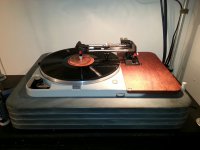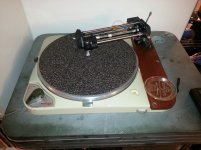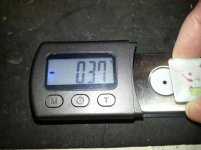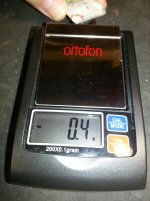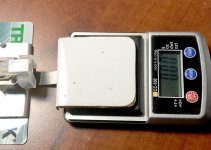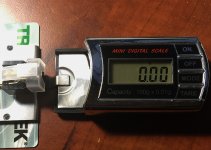Hi Bill,
I had to laugh when I read your comment about the cartridges. I never imagined I would end up with a bunch of them. In a now distant universe none of this would have been possible. I buy carefully and have a few friends who look for things I might like.
I need to investigate this MC2000 of which you speak.
I was somewhat disappointed to discover that an arm that looks like a junk box challenge, and which indeed I figuratively rescued from the tip (and which literally would have gone in the bin in the near future) with a cast off Benz could so easily embarrass a modern arm and top of the line SPU, but it did and it performs at about the same level as the arm I recently bought on eBay and stuck a used Windfeld on. They both seem to serve the music well, and the surprising lack of distortion and obvious arm resonances (All only obvious once they aren't there!) was an eye and ear opener. Plus they look cool as hell.. LOL
Strangely enough I think the Benz is a keeper as it works a treat on the Tri-Quartz which will continue to do its thing on table #2. Lapsing into audiophile speak it sounds clean, yet highly textured, kind of meaty, yet sweet and gutsy at the same time - great combination on this arm, and it is rugged enough for the mechanism. Less subjectively speaking it has a solid and well controlled bottom end, a lush and warm midrange and clean but not overstated highs. I am surprised to be describing it this way as I really did NOT like it in previous encounters on other arms. (Sorry for the subjective babble everyone )
)
The Windfeld is little different, it somewhat emphasizes speed, extension and detail over other attributes, but overall is very balanced and pleasant to listen to. I think the Benz images a hair better than the Windfeld, but the differences are fairly subtle.
Both combinations sound quite similar with the Tri-Quartz/Benz/Muscovite Mini III being slightly warmer overall. (I attribute this mainly to the cartridge)
I'm going to start working on the 401 shortly which will get the Schick and SPUs. Thinking Paperstone plinth. New thread when that happens.
I had to laugh when I read your comment about the cartridges. I never imagined I would end up with a bunch of them. In a now distant universe none of this would have been possible. I buy carefully and have a few friends who look for things I might like.
I need to investigate this MC2000 of which you speak.
I was somewhat disappointed to discover that an arm that looks like a junk box challenge, and which indeed I figuratively rescued from the tip (and which literally would have gone in the bin in the near future) with a cast off Benz could so easily embarrass a modern arm and top of the line SPU, but it did and it performs at about the same level as the arm I recently bought on eBay and stuck a used Windfeld on. They both seem to serve the music well, and the surprising lack of distortion and obvious arm resonances (All only obvious once they aren't there!) was an eye and ear opener. Plus they look cool as hell.. LOL
Strangely enough I think the Benz is a keeper as it works a treat on the Tri-Quartz which will continue to do its thing on table #2. Lapsing into audiophile speak it sounds clean, yet highly textured, kind of meaty, yet sweet and gutsy at the same time - great combination on this arm, and it is rugged enough for the mechanism. Less subjectively speaking it has a solid and well controlled bottom end, a lush and warm midrange and clean but not overstated highs. I am surprised to be describing it this way as I really did NOT like it in previous encounters on other arms. (Sorry for the subjective babble everyone
The Windfeld is little different, it somewhat emphasizes speed, extension and detail over other attributes, but overall is very balanced and pleasant to listen to. I think the Benz images a hair better than the Windfeld, but the differences are fairly subtle.
Both combinations sound quite similar with the Tri-Quartz/Benz/Muscovite Mini III being slightly warmer overall. (I attribute this mainly to the cartridge)
I'm going to start working on the 401 shortly which will get the Schick and SPUs. Thinking Paperstone plinth. New thread when that happens.
Ortofon MC-2000 MC phono cartridge | Stereophile.com
For those who hadn't heard of it, perhaps the daftest cartridge of the decade. Compliance of a MM and rediculously low output. I believe at a time, only John Curl had a phono stage that would work without a step up. Sadly Ortophon won't rebuild them as far as I can tell and the last bust one I saw on ebay was £300.
For those who hadn't heard of it, perhaps the daftest cartridge of the decade. Compliance of a MM and rediculously low output. I believe at a time, only John Curl had a phono stage that would work without a step up. Sadly Ortophon won't rebuild them as far as I can tell and the last bust one I saw on ebay was £300.
I read the review.. I hope the DCR was also extremely low and also in the primary of the companion transformer. I can't imagine the SNR would have been wonderful with anything commonly available at that time.
I've got lots of 200uV - 300uV cartridges with source impedances of 2 - 6 ohms. My preference is to the 2 ohm end of the spectrum. I have a multi-tan (chip based) head amp as well as two sets of Lundahl LL1941 configured for 16X, these feed one or the other of my tube based phono stages.
Were I to guess I suspect you would really like the Windfeld. I'm very impressed, it's neutral and detailed to a fault.
I've got lots of 200uV - 300uV cartridges with source impedances of 2 - 6 ohms. My preference is to the 2 ohm end of the spectrum. I have a multi-tan (chip based) head amp as well as two sets of Lundahl LL1941 configured for 16X, these feed one or the other of my tube based phono stages.
Were I to guess I suspect you would really like the Windfeld. I'm very impressed, it's neutral and detailed to a fault.
I'm in the process of re-evaluating the whole tone arm and cartridge thing. I might or might not be done with pivoted tone arms, some wrangling going on here. It's not looking good for the pivoted arm family however.
My experience with the SME 3009 and the GM E Series II and the Meister Silver GM II was not positive, both of these cartridges deserve a better arm. I had to add a 30gm counter weight in order to be able to balance the arm. I've never heard a 3009 sound better, that said I don't think I've heard an SPU sound much worse either. Throwing away a lot of the cartridge's potential. Different story with the 3012 which IMHO sounds much better than the 3009, but even there there are limits - the additional effective mass with the longer arm tube makes a big difference. The Schick is better than any vintage SME IMLE, can't speak to the 3012 Series I as that is a rather different animal, but probably the case here too.
I wanted an Xpression for a while, that lust is on hold for the moment.. lol No kids here, but we have cats and bunnies. Vet bills from time to time are breathtaking.
My experience with the SME 3009 and the GM E Series II and the Meister Silver GM II was not positive, both of these cartridges deserve a better arm. I had to add a 30gm counter weight in order to be able to balance the arm. I've never heard a 3009 sound better, that said I don't think I've heard an SPU sound much worse either. Throwing away a lot of the cartridge's potential. Different story with the 3012 which IMHO sounds much better than the 3009, but even there there are limits - the additional effective mass with the longer arm tube makes a big difference. The Schick is better than any vintage SME IMLE, can't speak to the 3012 Series I as that is a rather different animal, but probably the case here too.
I wanted an Xpression for a while, that lust is on hold for the moment.. lol No kids here, but we have cats and bunnies. Vet bills from time to time are breathtaking.
Hi,
Your revelations are very interesting. Your favorable SQ comparison of the Souther
LT to a highly regarded pivoted arm has forced me to reevaluate my tonearm upgrade path. I assume you removed that flimsy resonant plastic cover before auditioning. You mentioned that your Souther had a arm tube locking feature when cueing. I don't believe my SLA-3 had that. Please post some close up pictures of this mechanism when you have the chance. Finally please describe the SQ differences between the spindle support versus the non spindle support cantilevered arm. If there is a large difference, I may try to clone a similar assembly.
Thanks,
David
Your revelations are very interesting. Your favorable SQ comparison of the Souther
LT to a highly regarded pivoted arm has forced me to reevaluate my tonearm upgrade path. I assume you removed that flimsy resonant plastic cover before auditioning. You mentioned that your Souther had a arm tube locking feature when cueing. I don't believe my SLA-3 had that. Please post some close up pictures of this mechanism when you have the chance. Finally please describe the SQ differences between the spindle support versus the non spindle support cantilevered arm. If there is a large difference, I may try to clone a similar assembly.
Thanks,
David
My experience with the SME 3009 and the GM E Series II and the Meister Silver GM II was not positive, both of these cartridges deserve a better arm.
[snip]
I wanted an Xpression for a while, that lust is on hold for the moment.. lol No kids here, but we have cats and bunnies. Vet bills from time to time are breathtaking.
My irrational arm is the 3009 series 3. I just want to try and tame one. But I know it needs a high compliance cart as was optimised around the VST. The Schick is interesting, but hard to see where the money goes. I love my 309, which just gets on with the job and the concrete kenwood might get one of those when I get it running again.
Any chance of you doing a 3KHz recording off a test record for Luckythedog to analyse? would be interesting to see how the souther tames the LF wobbling.
Hi,
Your revelations are very interesting. Your favorable SQ comparison of the Souther
LT to a highly regarded pivoted arm has forced me to reevaluate my tonearm upgrade path. I assume you removed that flimsy resonant plastic cover before auditioning. You mentioned that your Souther had a arm tube locking feature when cueing. I don't believe my SLA-3 had that. Please post some close up pictures of this mechanism when you have the chance. Finally please describe the SQ differences between the spindle support versus the non spindle support cantilevered arm. If there is a large difference, I may try to clone a similar assembly.
Thanks,
David
Hi David,
The level of performance these arms achieve came as quite a surprise to me too. I was not expecting this particularly from the Tri-Quartz which was in very rough shape when I got it. I've done lots of work to clean it up and it does seem to be working rather well now.
I am not sure my SLA-3 was deliberately designed to lock the arm, it might be more of a fortuitous accident, best I can determine the flimsy plastic cover is the key, when in the fully up position the cuing lever on the carriage binds lightly against the cover, this may or may not be a deliberate design choice but I have no way to know. Since I have only a sample of one it could be simply that the slot routed in the cover for the cuing lever happens to be in the right place for this to happen. It's very handy whatever the cause, I suspect a stiffening bar placed in the right spot could accomplish the same thing. I haven't yet noted any significant difference with the cover on or off on the SLA-3 in terms of sound and because of the dust concern for now mostly leave it in place.
I'm still working on getting the SLA-3/Windfeld combo sorted out to my satisfaction, and will profess to having a slight preference for the Tri-Quart/Benz combo at the moment. It took me more than a few weeks of tinkering to get the original set up to work as well as it now does.
My irrational arm is the 3009 series 3. I just want to try and tame one. But I know it needs a high compliance cart as was optimised around the VST. The Schick is interesting, but hard to see where the money goes. I love my 309, which just gets on with the job and the concrete kenwood might get one of those when I get it running again.
Any chance of you doing a 3KHz recording off a test record for Luckythedog to analyse? would be interesting to see how the souther tames the LF wobbling.
The 309 seems to be a nice arm, but I have very limited experience with it. The Schick is not unreasonably expensive for its quality or in comparison to the arms it competes against. It's certainly the least fussy and easiest to use arm I have ever owned. I'm going to hold onto it and mount it on the 401 when it's done.
There are several LF phenomena when talking about the Souther, I assume you are referring to the moment of inertia issue in the vertical plane/vertical arm resonance with the counter weight out at the end of the arm or possibly the very noticeable effect of pressing offsets which would superimpose roughly 0.5Hz intermodulation on the signal - still true of course with a conventional pivoted arm, but much easier to observe.
I do have a 3140Hz track on one of my test records, it is possible at some point that I could make a recording of that and post it. Not imminent, and not until I am sure I have got things set up correctly, just because it works doesn't mean I in any sense know what I am doing
No rush, just would be nice to compare to all the plots we have for various arm/cart combos over what happens below 20Hz and what the FM lobes look like. George has a good collection of horrors plotted.
I will admit I had the price of the schick and the EMT 997 mixed up. $1500 for an arm is not silly. Same price as an SME 312. compared to some arms that look like a bit of car antenna an arm where you can stand on the armtube has a certain 'rugged' look I like . But once setup it stays there. Nothing to tweak, nothing to adjust. What I want for the TT that just 'works'. But I have a project table now which I why I love following your adventures.
I will admit I had the price of the schick and the EMT 997 mixed up. $1500 for an arm is not silly. Same price as an SME 312. compared to some arms that look like a bit of car antenna an arm where you can stand on the armtube has a certain 'rugged' look I like . But once setup it stays there. Nothing to tweak, nothing to adjust. What I want for the TT that just 'works'. But I have a project table now which I why I love following your adventures.
Hello Kevin,
If your arm tube locking system function as described, I'd keep a close eye on it. The friction holding the arm tube may loosen over time and suddenly give at an unfortunate moment. I would hate to hear about one of your expensive carts damaged because of this. You would never want to experience the arm tube/cart assembly sliding down the glass rods and slamming against the stop when you lift the arm to the upright position. I was lucky my Accuphase AC2 wasn't damaged when that happened to me.
The flimsy cover would ring when tapped. I feared that a certain frequency would excite that cover and introduce unwanted vibrations back into the stylus so I replaced it with a thick acrylic cover offered by Souther. At that time I had also removed that thin metal rod that would ring when tapped. It's purpose I believe was to keep the cart wire from binding. The arm worked fine without it.
Could you comment on the SQ difference between the use of the spindle support versus no spindle support.
Thanks,
David
If your arm tube locking system function as described, I'd keep a close eye on it. The friction holding the arm tube may loosen over time and suddenly give at an unfortunate moment. I would hate to hear about one of your expensive carts damaged because of this. You would never want to experience the arm tube/cart assembly sliding down the glass rods and slamming against the stop when you lift the arm to the upright position. I was lucky my Accuphase AC2 wasn't damaged when that happened to me.
The flimsy cover would ring when tapped. I feared that a certain frequency would excite that cover and introduce unwanted vibrations back into the stylus so I replaced it with a thick acrylic cover offered by Souther. At that time I had also removed that thin metal rod that would ring when tapped. It's purpose I believe was to keep the cart wire from binding. The arm worked fine without it.
Could you comment on the SQ difference between the use of the spindle support versus no spindle support.
Thanks,
David
Hi Dave,
I was wrong on a couple of counts. Tonight I removed the flimsy cover and I think it actually is a little better without it. I was pretty convinced it wasn't and couldn't be that audible, but it appears the street wisdom on this might be correct.
I also took a really close look at the carriage locking behavior, it's apparently not accidental and has nothing to do with the cover as I surmised; with it removed it locks just as nicely as before. This it does by forcing the carriage bottom to into contact with the bottom of the rods. I suspect it nothing more than a minor adjustment to the cuing lever travel limit screw. The SLA-3 had not been touched by anyone since it left the factory which I know is not the case with my Tri-Quartz which incorporates just about every modification known to man. It has a locking position that the later arm either never had or was defeated during modification.
Edit: I found a difference, the SLA-3 uses short screw as a travel stop for the cuing, and allows about another 20 degrees of travel as compared to the Tri-Quartz. The TQ has a threaded rod which sticks out much further and limits the travel at the top of the cuing lever rotation. I think that's it basically, the shorter screw allows the cuing to bung the carriage into the bottom of the rods, which IMHO is a good idea. There must have been a concern as the SN 35xx SLA-3 has it and the SN 45xx Tri-Quartz doesn't, looks like a running change to me.
I was wrong on a couple of counts. Tonight I removed the flimsy cover and I think it actually is a little better without it. I was pretty convinced it wasn't and couldn't be that audible, but it appears the street wisdom on this might be correct.
I also took a really close look at the carriage locking behavior, it's apparently not accidental and has nothing to do with the cover as I surmised; with it removed it locks just as nicely as before. This it does by forcing the carriage bottom to into contact with the bottom of the rods. I suspect it nothing more than a minor adjustment to the cuing lever travel limit screw. The SLA-3 had not been touched by anyone since it left the factory which I know is not the case with my Tri-Quartz which incorporates just about every modification known to man. It has a locking position that the later arm either never had or was defeated during modification.
Edit: I found a difference, the SLA-3 uses short screw as a travel stop for the cuing, and allows about another 20 degrees of travel as compared to the Tri-Quartz. The TQ has a threaded rod which sticks out much further and limits the travel at the top of the cuing lever rotation. I think that's it basically, the shorter screw allows the cuing to bung the carriage into the bottom of the rods, which IMHO is a good idea. There must have been a concern as the SN 35xx SLA-3 has it and the SN 45xx Tri-Quartz doesn't, looks like a running change to me.
Hello Kevin,
<snip>
Could you comment on the SQ difference between the use of the spindle support versus no spindle support.
Thanks,
David
For whatever reason Lou Souther was adamantly opposed to the fulcrum end support that Clear Audio came up with - he maintained that it needed to be supported at both ends of the arm. (This according to the former owner of my Tri-Quartz who actually knew Lou Souther)
For the moment I don't have a viable way to do a direct comparison, the SLA-3 spindle bushing profile is not correct for the spindle on the 124 which is normally a none issue except if I want to do this very experiment. All I can say is the the Tri-Quartz without the support still manages to sound marginally better most of the time than the SLA-3 with it. We're not talking a huge difference here.
The SLA-3 came with an optional brass arm wand which I have just installed in place of the hollow titanium arm wand (with the filler rod) and it is definitely preferable, some sibilance I heard on some female vocal passages is much reduced. (The TQ/Benz exhibits virtually no sibilance at all on that particular passage.)
I would say the hollow arm tubes should be avoided.
The set up guidelines for arm height should probably be ignored, modern cartridges seem to be substantially taller than the cartridges Souther was thinking of when those instructions were written.
I would say the hollow arm tubes should be avoided.
The set up guidelines for arm height should probably be ignored, modern cartridges seem to be substantially taller than the cartridges Souther was thinking of when those instructions were written.
A few further cartridge thoughts. I'd say anything much over 11gms is really too heavy, although cartridges up to 13gms can be made to work satisfactorily.
The Windfeld VTA adjustment is extremely critical, more so than the other replicant/line contact stylus equipped cartridges I own. The result of getting this wrong is sibilants on some vocals which becomes very pronounced on the inner grooves but is audible everywhere on the disk. Get this set correctly and it disappears, but the window of adjustment is small enough it can be missed. VTA adjustment is pretty easy on the Souther as long as you are not using the CA support at the fulcrum.
I would say cartridge weights of 5 - 11 gms and tracking forces of 2gms or greater work well. No tracking issues with compliances of 12 - 16 cu so far.
The Benz Ebony series is just about ideal.
A couple of dozen records played over the past 6 days with both arms, no skipping on either.
The Windfeld VTA adjustment is extremely critical, more so than the other replicant/line contact stylus equipped cartridges I own. The result of getting this wrong is sibilants on some vocals which becomes very pronounced on the inner grooves but is audible everywhere on the disk. Get this set correctly and it disappears, but the window of adjustment is small enough it can be missed. VTA adjustment is pretty easy on the Souther as long as you are not using the CA support at the fulcrum.
I would say cartridge weights of 5 - 11 gms and tracking forces of 2gms or greater work well. No tracking issues with compliances of 12 - 16 cu so far.
The Benz Ebony series is just about ideal.
A couple of dozen records played over the past 6 days with both arms, no skipping on either.
I've really been struggling with the Windfeld in the SLA-3, this cartridge is extremely sensitive to both SRA and azimuth, very small changes in either generally result in profound changes in performance - usually in the wrong direction.
Add to this the discovery that my stylus force gauge, an inexpensive Asian made thing that looks like some much more expensive devices is a lying piece of <expletive deleted>. The measurement platform is made of a magnetic form of stainless steel, with MC cartridges with powerful magnets this results in tracking force settings that are far less than what the gauge reports - errors of a gram or more are possible, and the Windfeld has extremely power magnets, as it approaches within 6mm or so of the gauge you can see the reading move off of zero and into the negative force range. (0.2gms or more) I am sure as the cartridge rests on the actual platform the attraction is much, much greater. This gauge is therefore useless as a means for setting the tracking force. Some of my problems with the Windfeld undoubtedly stem from this issue.
Add to this the discovery that my stylus force gauge, an inexpensive Asian made thing that looks like some much more expensive devices is a lying piece of <expletive deleted>. The measurement platform is made of a magnetic form of stainless steel, with MC cartridges with powerful magnets this results in tracking force settings that are far less than what the gauge reports - errors of a gram or more are possible, and the Windfeld has extremely power magnets, as it approaches within 6mm or so of the gauge you can see the reading move off of zero and into the negative force range. (0.2gms or more) I am sure as the cartridge rests on the actual platform the attraction is much, much greater. This gauge is therefore useless as a means for setting the tracking force. Some of my problems with the Windfeld undoubtedly stem from this issue.
I took the plastic cover off of the SLA-3 a few days ago... I have done quite a lot of tweaking and it appears that the Windfeld can work well on this arm - not a given however as it is heavier than the optimum, and incredibly sensitive to SRA (VTA), it's been a rough go complicated by the fact that the stylus pressure gauge interacts with the magnetic field and sometimes gives erratic tracking force readings, unfortunately the just acquired Ortofon DS-1 has the same flaw as the stainless steel used is quite magnetic. It is otherwise much easier to use with the Souther Arms.
I've attached photographs of the said gauges with an external magnet in proximity to the measurement surface. I observe the same effects with the cartridge bodies in close proximity to the pans. In theory this actually should not cause an error in readings of externally applied tracking force, but it creates some uncertainty as you try to measure the tracking force. (Need to allow time for everything to settle)
I've attached photographs of the said gauges with an external magnet in proximity to the measurement surface. I observe the same effects with the cartridge bodies in close proximity to the pans. In theory this actually should not cause an error in readings of externally applied tracking force, but it creates some uncertainty as you try to measure the tracking force. (Need to allow time for everything to settle)
Attachments
I don't know why you have trouble with your scales. That Ortofon scale costs over $100. I will never buy that while I know it only worth less $15.00. I have two scales. Both cost less than $15.00. One has accuracy of .01 g and another has .05 g. After I read your post, I tried to make sure mine working properly. I also used a very strong magnet to do experiments. Both scales worked fine if I put the magnet on the lip. But if I put the magnet on direct top of the scales, I got .4 readings.
Attachments
- Status
- This old topic is closed. If you want to reopen this topic, contact a moderator using the "Report Post" button.
- Home
- Source & Line
- Analogue Source
- Souther Linear Tonearm on A TD-124
